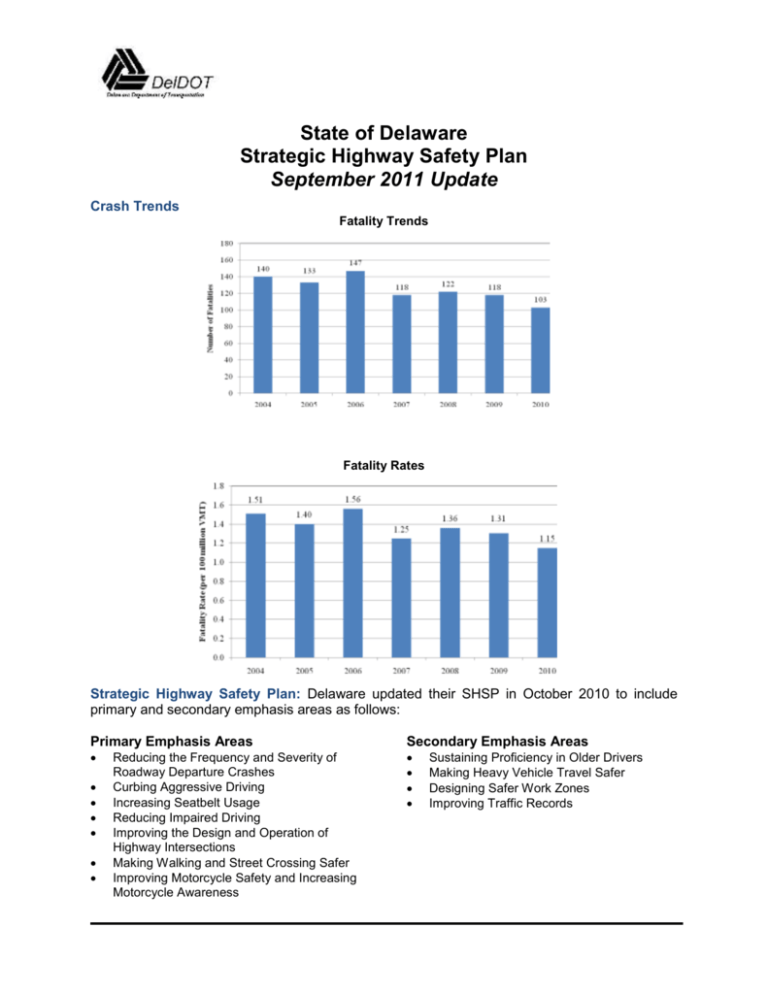Delaware State Report 2011
advertisement

State of Delaware Strategic Highway Safety Plan September 2011 Update Crash Trends Fatality Trends Fatality Rates Strategic Highway Safety Plan: Delaware updated their SHSP in October 2010 to include primary and secondary emphasis areas as follows: Primary Emphasis Areas Secondary Emphasis Areas Reducing the Frequency and Severity of Roadway Departure Crashes Curbing Aggressive Driving Increasing Seatbelt Usage Reducing Impaired Driving Improving the Design and Operation of Highway Intersections Making Walking and Street Crossing Safer Improving Motorcycle Safety and Increasing Motorcycle Awareness Sustaining Proficiency in Older Drivers Making Heavy Vehicle Travel Safer Designing Safer Work Zones Improving Traffic Records Safety Initiatives The following highlights some of the new programs and projects that Delaware has initiated in 2010 - 2011 to reduce fatalities and address the key emphasis areas and implement the strategies identified in the Strategic Highway Safety Plan. Minimizing the Severity of Roadway Departure Crashes: DelDOT is currently finalizing an Action Plan for the Removal of Fixed Objects from the Clear Zone. This data-driven plan supports the Reducing the Frequency and Severity of Roadway Departure Crashes emphasis area. The action plan includes both proactive and reactive components and includes plans for an inventory of fixed objects within the clear zone along all state-maintained roadways (excluding subdivision streets). The public outreach campaign will kick-off in November 2011 followed by the inventory and removal of fixed objects. The inventory will be prioritized based on the functional classifications with the highest fatal roadway departure crash rate per mile. Minimizing the Frequency of Roadway Departure Crashes: In May 2011, DelDOT adopted new guidelines for the installation of continuous centerline and longitudinal edge line rumble strips to support the Reducing the Frequency and Severity of Roadway Departure Crashes emphasis area. The Design Guidance Memorandum (DGM) contains guidance for limitedaccess facilities, multi-lane roadways, and two-lane roadways and generally increases the requirements for installation of rumble strips which will result in a higher portion of roadways with rumble strips statewide, thereby decreasing the frequency of roadway departure crashes. Improving Traffic Records: DelDOT is currently developing a map-based Crash Analysis Reporting System (CARS) in response to DSP and DelJIS’s development of E-Crash, a new statewide electronic crash reporting system. The new Crash Analysis Reporting System (CARS) has replaced the existing Safety Data Management (SDM) system and will allow for the identification of high crash rate locations for various crash types and characteristics. For example, a user will be able to calculate a crash rate for a specific roadway segment and crash type (e.g., wet weather, nighttime, run-off-the-road, fixed object) and determine whether the crash rate is higher than the average crash rate for similar types of roadways. The new program has also streamlined the site identification process for all HSIP elements (e.g. HEP, HRRRP, Transparency Report). Motorcycle Safety: The Office of Highway Safety (OHS) launched its 2010 Ride Safe. Ride Smart. Motorcycle Safety campaign in early April in support of the Improving Motorcycle Safety and Increasing Motorcycle Awareness emphasis area. The campaign, a combination of both enforcement and awareness activities, is an effort to reduce motorcycle fatalities and injuries. Throughout the campaign, Delaware State, Dover, Felton Police, Middletown, Newark and New Castle County Police Departments conduct patrols on high-crash roadways. Public awareness efforts are aimed at reaching not only motorcyclists but also the drivers of passenger vehicles. Motorists are encouraged to Share the Road with motorcyclists through billboard and radio messaging. Motorcycle operators are being reminded, through billboard and radio messaging, to Ride Smart. Stay Safe. by not speeding or riding while under the influence of alcohol. Additionally, safety brochures, window decals and bumper stickers are being distributed through OHS partners, including motorcycle rider groups. OHS awareness efforts in the last four years have fostered a stronger partnership with the state's Motorcycle Safety Committee, on which OHS now has a seat. The Committee also includes motorcycle riders, businesses, advocacy groups and representatives of the DMV Motorcycle Rider Training Program.






